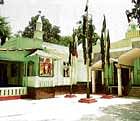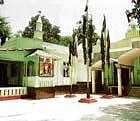
This was how Netaji Subhash Chandra Bose ended his speech with a favoured Bahadur Shah couplet while paying glowing tributes at his tomb at a ceremonial parade of the INA (Indian National Army) on July 11, 1944. “This parade,” declared Netaji, “is the first occasion when India’s new revolutionary army is paying homage to the spirit of the supreme commander of India’s first revolutionary army.”
But it seems we have forgotten that harbinger of interfaith harmony and symbol of communal concord. Not only that the last Mughal Emperor was hapless, his progeny seems to be in a worse condition.
Kitna hai badnasib Zafar kafn kay liye,
Do gaz zameen bhi na mili ku-e-yar mein.
(How unfortunate is Zafar, for his burial in his own country/ He could not get a grave in his heart’s territory).
Emperor Bahadur Shah Zafar’s great grand daughter, Madhu, 35, who resides in Kolkata’s 66 sq feet room in a Shibpur slum near Cowies Ghat in Howrah, could well be reciting the same couplet these days. Madhu is not the only one who suffers in silence. She is the one of the five daughters of Sultana Begum, who was married to Mirza Bedar Bakht Bahadur, grandson of Bahadur Shah Zafar, on August 15, 1965.
Bedar Bakht, who used to sharpen knives and pairs of scissors on a bicycle, died in 1980 in penury leaving behind an impoverished family. Sultana Begum, 59, mother of Madhu and the grand daughter-in-law of Zafar, told us, “I am thankful to Shivnath Jha, a journalist, and wife Neena, who are doing their best to provide me bread and shelter through the proceeds of a book Prime Ministers of India: Bharat Bhagya Vidhata (1947-2009) compiled and edited by the duo.”
Of the eight wives of Emperor Zafar, one was Zeenat Mahal who had a son, Jawan Bakht who had also settled in Burma and had a son Jamshed Bakht. Jamshed had two sons, Mirza Sikandar Bakht and Bedar Bakht, the husband of Sultana Begum of Kolkata.
Many efforts have been made to shift the mortal remains of Zafar to Delhi where he had prepared his grave in advance in Zafar Mahal (lying empty) but nothing materialised. The first of such effective efforts was made by Maulana Abul Kalam Azad in 1925. The government reacted by saying the descendants couldn’t be brought to Delhi but could be taken to Kolkata and that too on condition that they do not tell anyone about their Mughal lineage. As a result, these people were brought in a box carrying flowers to Kolkata.
A passionate Indian visitor like me cannot help feeling sad. There is no match between the grand and glorious stature of Bahadur Shah Zafar and the pathetic grave of his in Yangon. Unceremoniously tucked away in an unnoticeable nook of the city, the nondescript tomb of Zafar is dying in obscurity.
Bahadur Shah Zafar was crowned in Delhi on September 18, 1838. At that time he was 60. At the age of 85 he was brought to Yangon as a Royal Captive of the British. He was brought to Yangon on a Mackinon McKenzie ship from Calcutta. He was accompanied by 35 men and women who were part of his family and staff. The ship was anchored at Calcutta’s Jetty Road from where Zafar was brought to his place of captivity by carriage. The queen and others were brought in closed carts.
When India’s first war of Independence ended in 1857, the victors were confronted with a major question: What should be done with its leader, Bahadur Shah Zafar, the last Mughal Emperor. He occupied the throne of Delhi from 1836 to 1857.
The British come up with a typical solution, inspired by the mindset of ‘divide and rule’. The diktat was to send the emperor in permanent exile to a far corner of the Raj, a deserted, desolate part of Rangoon, the sleepy city they had conquered recently. (They had meted out the same treatment to Thibwa, the last King of Burma, sent on exile to Ratnagiri in Maharashtra).
At first, Captain Nelson Davies, the British officer-in-charge did not know what to do with his new charge. Setting aside protocol, he decided to accommodate the prisoner in the small garage of his modest bungalow. That is where Zafar, accompanied by his wife, Begum Zeenat Mahal, and grand-daughter princess Raunaq Zamani, along with two sons and other members of the entourage, spent the sunset years of his life from 1858-62.
Bahadur Shah died on November 7, 1862, at a ripe old age of 89. The British feared him, even in his death. He was immediately buried in the British officer’s residential compound. Prince Jawan Bakht and his teacher Hafiz Mohammed Ibrahim Dehlavi arranged for the funeral prayers and his burial.
The burial site was concealed carefully and in no time, it was covered with tropical foliage. Davies wrote, as cited by former Punjab High Court Chief Justice GD Khosla in his book The Last Mughal: “A bamboo fence surrounded the grave for some considerable distance. By the time the fence worn out, the grass will have again covered the spot and no vestige will remain to distinguish where the last of great Mughals rests.”
Clearly, the British knew the symbolic value and the emotional hold of Bahadur Shah Zafar on the people of Hindustan. There was a time that the English thought of flattening the grave of Zafar, however, fortunately it was warded of. Nevertheless, history proved Davies and the Raj completely wrong. Neither the king nor his mausoleum has been forgotten.
For local Muslims, Zafar’s grave is a place of worship where namaz is offered everyday and large congregations gather on special holy days. He has been revered as wali (saint), blessed with special powers. His death anniversary is celebrated by holding a huge urs (religious congregation) lasting three days when free meals are served to visitors and musical events are held.
FIROZ BAKHT AHMED
